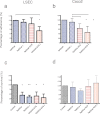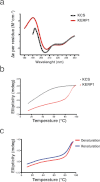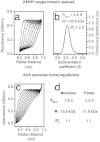The α-helical regions of KERP1 are important in Entamoeba histolytica adherence to human cells
- PMID: 23378906
- PMCID: PMC3558696
- DOI: 10.1038/srep01171
The α-helical regions of KERP1 are important in Entamoeba histolytica adherence to human cells
Abstract
The lysine and glutamic acid rich protein KERP1 is a unique surface adhesion factor associated with virulence in the human pathogen Entamoeba histolytica. Both the function and structure of this protein remain unknown to this date. Here, we used circular dichroism, analytical ultracentrifugation and bioinformatics modeling to characterize the structure of KERP1. Our findings revealed that it is an α-helical rich protein organized as a trimer, endowed with a very high thermal stability (Tm = 89.6°C). Bioinformatics sequence analyses and 3D-structural modeling indicates that KERP1 central segments could account for protein trimerization. Relevantly, expressing the central region of KERP1 in living parasites, impair their capacity to adhere to human cells. Our observations suggest a link between the inhibitory effect of the isolated central region and the structural features of KERP1.
Figures






Similar articles
-
A lysine- and glutamic acid-rich protein, KERP1, from Entamoeba histolytica binds to human enterocytes.Cell Microbiol. 2005 Apr;7(4):569-79. doi: 10.1111/j.1462-5822.2005.00487.x. Cell Microbiol. 2005. PMID: 15760457
-
Intracellular traffic of the lysine and glutamic acid rich protein KERP1 reveals features of endomembrane organization in Entamoeba histolytica.Cell Microbiol. 2016 Aug;18(8):1134-52. doi: 10.1111/cmi.12576. Epub 2016 Feb 26. Cell Microbiol. 2016. PMID: 26857352
-
The lysine- and glutamic acid-rich protein KERP1 plays a role in Entamoeba histolytica liver abscess pathogenesis.Cell Microbiol. 2008 Jan;10(1):202-17. doi: 10.1111/j.1462-5822.2007.01030.x. Epub 2007 Aug 17. Cell Microbiol. 2008. PMID: 17711481
-
The pore-forming peptide of Entamoeba histolytica, the protozoan parasite causing human amoebiasis.Toxicology. 1994 Feb 28;87(1-3):5-18. doi: 10.1016/0300-483x(94)90151-1. Toxicology. 1994. PMID: 7512763 Review.
-
Structure and function of the Entamoeba histolytica Gal/GalNAc lectin.Int Rev Cytol. 2002;216:59-80. doi: 10.1016/s0074-7696(02)16003-7. Int Rev Cytol. 2002. PMID: 12049210 Review.
Cited by
-
Genetic characterization of the Entamoeba moshkovskii population based on different potential genetic markers.Parasitology. 2024 Apr;151(4):429-439. doi: 10.1017/S003118202400026X. Epub 2024 Mar 11. Parasitology. 2024. PMID: 38571301 Free PMC article.
-
The Minor Capsid Protein VP11 of Thermophilic Bacteriophage P23-77 Facilitates Virus Assembly by Using Lipid-Protein Interactions.J Virol. 2015 Aug;89(15):7593-603. doi: 10.1128/JVI.00262-15. Epub 2015 May 13. J Virol. 2015. PMID: 25972558 Free PMC article.
-
Impact of Reactive Sulfur Species on Entamoeba histolytica: Modulating Viability, Motility, and Biofilm Degradation Capacity.Antioxidants (Basel). 2024 Feb 19;13(2):245. doi: 10.3390/antiox13020245. Antioxidants (Basel). 2024. PMID: 38397843 Free PMC article.
-
Integrating computational modeling and functional assays to decipher the structure-function relationship of influenza virus PB1 protein.Sci Rep. 2014 Nov 26;4:7192. doi: 10.1038/srep07192. Sci Rep. 2014. PMID: 25424584 Free PMC article.
-
Chew on this: amoebic trogocytosis and host cell killing by Entamoeba histolytica.Trends Parasitol. 2015 Sep;31(9):442-52. doi: 10.1016/j.pt.2015.05.003. Epub 2015 Jun 9. Trends Parasitol. 2015. PMID: 26070402 Free PMC article. Review.
References
-
- Stanley S. L. Jr Amoebiasis. Lancet 361, 1025–1034 (2003). - PubMed
-
- Seigneur M., Mounier J., Prevost M. C. & Guillen N. A lysine- and glutamic acid-rich protein, KERP1, from Entamoeba histolytica binds to human enterocytes. Cell Microbiol 7, 569–579 (2005). - PubMed
-
- Santi-Rocca J. et al. The lysine- and glutamic acid-rich protein KERP1 plays a role in Entamoeba histolytica liver abscess pathogenesis. Cell Microbiol 10, 202–217 (2008). - PubMed
-
- Burkhard P., Stetefeld J. & Strelkov S. V. Coiled coils: a highly versatile protein folding motif. Trends Cell Biol 11, 82–88 (2001). - PubMed
-
- Parry D. A., Fraser R. D. & Squire J. M. Fifty years of coiled-coils and alpha-helical bundles: a close relationship between sequence and structure. J Struct Biol 163, 258–269 (2008). - PubMed
Publication types
MeSH terms
Substances
LinkOut - more resources
Full Text Sources
Other Literature Sources

